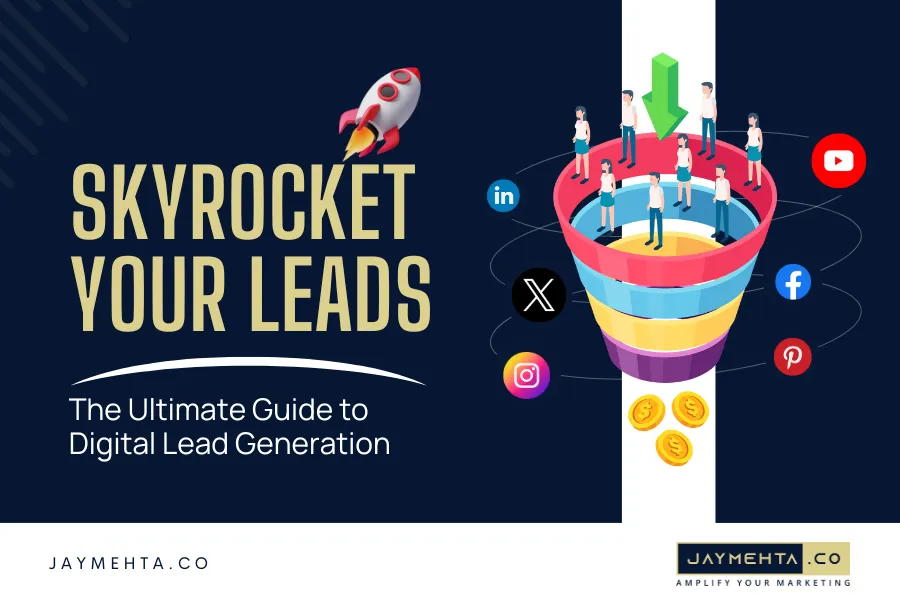In the fast-paced world of digital marketing, understanding what is lead generation in digital marketing and how to effectively implement it can be the key to your business’s success. Lead generation is the process of attracting potential customers and capturing their interest, ultimately turning them into paying clients.
With countless businesses vying for consumer attention, mastering lead generation strategies is essential for standing out in a crowded market. Many businesses ask how to get more leads, but they don’t understand all the basics first.
This article will explore the ins and outs of lead generation in digital marketing. We will cover various techniques, tools, and best practices to help you learn how to get more leads for your business. Whether you’re a seasoned marketer or just starting, this guide will provide valuable insights to enhance your lead generation efforts.
Understanding Lead Generation: The Basics
Lead generation refers to the process of identifying and attracting potential customers who have shown interest in your products or services. These individuals are known as leads. The ultimate goal of lead generation is to convert these interested parties into paying customers.
What Is a Lead?
A lead can be defined as anyone who has expressed interest in your business. This could be through various interactions, such as signing up for a newsletter, downloading a free resource, or engaging with your brand on social media. In digital marketing, leads are often categorized into three main types:
-
Information-qualified leads (IQL)
These leads have provided some information about their needs.
-
Marketing-qualified leads (MQL)
These individuals have engaged with your marketing efforts but may not be ready to purchase yet.
-
Sales-qualified leads (SQL)
These leads have expressed a clear interest in becoming customers.
Why Is Lead Generation Important?
Lead generation is crucial because it helps businesses build a pipeline of potential customers. Without effective lead generation strategies, companies may struggle to attract new clients and grow their sales. By focusing on individuals who have already shown interest in your offerings, you can create more targeted marketing campaigns that resonate with their needs. For companies asking how to get more leads for my business, finding ways to generate leads should be a high priority.
Read also: Google AI: The Lead Generation Powerhouse – Insights for 2025
The Lead Generation Process: Step by Step
Understanding the lead generation process is essential for implementing successful strategies. Here’s a breakdown of the typical stages involved:
-
Stage 1: Awareness
The first step in lead generation is creating awareness about your brand and offerings. This can be achieved through various channels such as content marketing, social media, email campaigns and paid advertising.
-
Stage 2: Interest
Once potential customers are aware of your brand, the next step is to pique their interest. This can be done by providing valuable content that addresses their pain points or offering free resources that showcase your expertise.
-
Stage 3: Consideration
At this stage, leads are evaluating their options and considering whether to engage with your business further. Providing testimonials, case studies, and detailed product information can help sway their decision in your favor.
-
Stage 4: Conversion
The final stage is converting leads into paying customers. This often involves nurturing leads through targeted email campaigns or personalized follow-ups that encourage them to make a purchase.
Read also: Guide to Using the Power of SEO to Build Your Brand Awareness
Effective Lead Generation Strategies
To successfully generate leads, businesses must employ effective strategies tailored to their target audience. Here are some proven techniques:
-
Content Marketing
Creating high-quality content that addresses the needs of your audience is one of the most effective ways to generate leads. This can include blog posts, eBooks, webinars, and videos that provide valuable insights and solutions.
-
Social Media Engagement
Social media platforms offer an excellent opportunity to connect with potential customers. Engage with your audience by sharing relevant content, responding to comments, and participating in discussions related to your industry.
-
Email Marketing
Building an email list allows you to nurture leads over time. Send regular newsletters featuring valuable content and exclusive offers to keep your audience engaged and encourage conversions. Many companies find success through quality lead generation services.
Utilizing Technology for Lead Generation
In today’s digital landscape, technology plays a significant role in streamlining lead generation efforts. Here are some tools that can help:
-
Customer Relationship Management (CRM) Systems
CRM systems help businesses manage interactions with potential customers by organizing contact information and tracking engagement history. This allows marketers to tailor their outreach efforts based on individual preferences.
-
Marketing Automation Tools
Marketing automation tools enable businesses to automate repetitive tasks such as email campaigns and social media posting. This saves time and ensures consistent communication with leads.
-
Chatbots
Chatbots provide immediate responses to website visitors’ inquiries, helping capture leads in real-time. They can engage users by answering questions or directing them toward relevant resources.
Measuring Lead Generation Success
To ensure your lead generation efforts are effective, it’s essential to track key performance indicators (KPIs). Some important metrics include:
-
Conversion Rate
The percentage of leads that become paying customers.
-
Cost per Lead (CPL)
The total cost associated with acquiring each lead.
-
Lead Source Performance
Analyzing which channels generate the most qualified leads helps optimize future campaigns.
By regularly monitoring these metrics, you can identify areas for improvement and adjust your strategies accordingly. Improving lead generation and marketing requires close measurement.
Common Lead Generation Mistakes to Avoid
While implementing lead generation strategies, it’s crucial to avoid common pitfalls that could hinder success:
-
Focusing Solely on Quantity Over Quality
While generating a large number of leads may seem appealing, it’s essential to prioritize quality over quantity. Targeting individuals who are genuinely interested in your offerings will yield better results than casting a wide net without proper segmentation.
-
Neglecting Follow-Up Communication
Failing to follow up with leads after initial contact can result in lost opportunities. Develop a systematic approach for nurturing leads through timely follow-ups via email or phone calls.
-
Ignoring Data Analysis
Data analysis provides valuable insights into the effectiveness of your lead generation efforts. Ignoring this information can prevent you from making informed decisions about future strategies.
Leveraging Social Proof for Lead Generation
Social proof plays a vital role in building trust with potential customers. Here are some ways to leverage social proof for effective lead generation:
-
Customer Testimonials
Showcasing positive feedback from satisfied customers can significantly influence potential buyers’ decisions. Display testimonials prominently on your website or social media pages.
-
Case Studies
Detailed case studies demonstrate how your products or services have helped other clients achieve success. Sharing these stories helps establish credibility and encourages prospects to consider engaging with your brand.
-
Influencer Partnerships
Collaborating with influencers within your industry can help expand your reach and attract new leads. Influencers often have established trust with their followers, making their endorsements valuable for generating interest in your offerings.
The Role of SEO in Lead Generation
Search engine optimization (SEO) is crucial for driving organic traffic to your website and generating leads. Here’s how SEO contributes:
-
Keyword Research
Identifying relevant keywords that potential customers are searching for allows you to create content that aligns with their interests. Incorporating these keywords into your website helps improve visibility on search engines.
-
On-Page Optimization
Optimizing individual web pages ensures they rank higher in search results. This includes using appropriate meta tags, headings, and internal linking structures that enhance user experience.
-
Local SEO Strategies
For businesses targeting local markets, optimizing for local search terms is essential. Claiming Google My Business listings and encouraging customer reviews can improve visibility among local prospects.
Read also: SEO Best Practices for 2025: Key Strategies to Implement
Nurturing Leads Through Effective Communication
Once you’ve captured leads’ information, nurturing them through effective communication is vital for conversion:
-
Personalized Email Campaigns
Tailoring email campaigns based on individual preferences helps create a more engaging experience for recipients. Use data collected from previous interactions to segment audiences effectively.
-
Valuable Content Delivery
Continuously providing valuable content keeps prospects engaged throughout the sales funnel. Share informative articles or resources that address their pain points while subtly promoting your products or services.
-
Timely Follow-Ups
Sending timely follow-up emails after initial contact demonstrates attentiveness and keeps the conversation going with potential clients.
Conclusion: Start Generating Leads Today!
Once you’ve captured leads’ information, nurturing them through effective communication is vital for conversion:
Lead generation is an essential component of successful digital marketing strategies aimed at attracting new clients and growing sales revenue. By understanding what is lead generation in digital marketing and implementing effective techniques tailored to your target audience’s needs, you can significantly enhance your business’s growth potential, especially if you’re looking at how to get more business leads effectively!
Whether you’re utilizing content marketing, social media engagement, or advanced technology tools like CRM systems and chatbots—each strategy plays a vital role in capturing qualified leads effectively.
FAQs: Your Questions Answered
What is lead generation?
Lead generation is the process of attracting potential customers who have shown interest in a product or service.
Why is lead generation important?
It helps businesses build a pipeline of interested prospects who are more likely to convert into paying customers.
What are some effective lead generation strategies?
Content marketing, social media engagement, email marketing, and utilizing technology tools like CRM systems.
How do I measure my lead generation success?
Track key performance indicators such as conversion rate, cost per lead (CPL), and source performance.
What common mistakes should I avoid?
Focusing solely on quantity over quality, neglecting follow-up communication, and ignoring data analysis.
How does social proof contribute to lead generation?
Positive testimonials and case studies build trust with potential customers and encourage them to engage with your brand.
What role does SEO play in lead generation?
SEO improves visibility on search engines by optimizing web pages for relevant keywords that prospective customers are searching for.
How do I nurture my leads effectively?
Use personalized email campaigns, deliver valuable content consistently, and send timely follow-ups after initial contact.
Can I automate my lead generation efforts?
Yes! Using marketing automation tools allows you to streamline repetitive tasks while maintaining consistent communication with prospects.
Where can I learn more about digital marketing?
Websites like Jay Mehta Digital offer comprehensive guides on digital marketing strategies including lead generation techniques.













